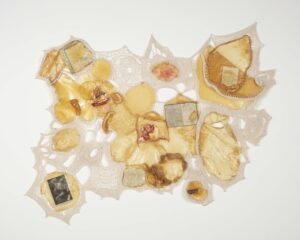
Ophelia Arc: we’re just so glad you’re home at 81 Leonard Gallery
by Joanna Seifter, Art Spiel
May 26, 2024
In her 2014 essay Grand Unified Theory of Female Pain, Leslie Jamison examines the literary phenomenon of women’s suffering being depicted in almost luxuriating detail, as much an object of fetishization by men as it is a subject of shame by women. Jamison recalls a boyfriend accusing her of being a “wound-dweller,” or fixating on her own afflictions to an unhealthy, self-centered degree, to which she initially reacts with umbrage. Ultimately, she reworks this pejorative into an argument that women’s tragedy, disease and self-harm should be viewed through an empathetic lens, that women should be inclined to give themselves the space to “dwell” on their wounds as a pathway to solidarity and recovery.
Ten years later, contemporary artist Ophelia Arc’s flesh home dialogues with Jamison’s “wound-dweller” framework, envisioning a “dwelled” wound as a physical place of refuge. Equal parts sculpture and tapestry, flesh home’s intricate stitchwork, both tight double-crochet stitches and hatched mesh stitches, assumes the rough texture and elasticity of lacerated human skin, or perhaps an organ’s gnarled flesh. Here, healing and freshly reopened wounds are the artist’s visualizations of her trauma, materialized with and measured by every suture. flesh home’s cagelike structure coupled with a demonstrational video invites the viewer into Arc’s wound, and is one of the many works featured in Arc’s solo exhibition at 81 Leonard Gallery, we’re just so glad you’re home, on now through June 1. Arc’s work, equal parts technically impressive and thematically ambitious, is an exciting development in the burgeoning generation of fiber artists and designers redefining the medium’s capabilities and perception.
Resembling a butcher’s cluttered stockroom of large-scale organs pinned through meathooks, we’re just so glad you’re home materializes Arc’s wounds in a number of forms. We see her pain as a malformed changeling in neglected experimental animal i, as rotting fruit in gray mold, and as fragmented childhood memories in as lonely as i have ever been. In her cytoplasmic tapestry i love beginnings!, Arc deftly connects these disparate images, including yellowed swatches of diseased flesh, decontextualized family photos, patches of matted hair, pages from diary entries past, and discarded dinner plates, with intricate crochet lacework. Arc also harnesses crochet’s meditative properties, the comforting rhythms sustained by completing countless identical stitches[1], as a physical manifestation of, and attempts to heal, her dwelled wounds in sculptures like rumination loop and system for draining wounds.
Arc’s tapestries and sculptures are primarily composed of dusty rose and mauve acrylic yarn and tulle, colors and textures that easily lend themselves to the “coquette girl” aesthetics proliferating on Gen Z social media. This trend, exemplified by films like The Virgin Suicides and artists like Lana del Rey, juxtaposes stereotypically feminine, dainty, or youthful aesthetics like pink bows, camisoles, and ruffled ankle socks with vices and self-harm. The young girls that aspire to this style romanticize misery as a cute badge of honor and femininity; referring once again to Jamison, the “coquette girl” aesthetic “risks transforming [women’s] suffering from an aspect of the female experience into an element of the female constitution.”[2]
The artist’s use of crochet, historically dismissed and demeaned as “women’s work,” and a craft rather than a fine art form, reclaims the practice of “wound dwelling”; Arc’s unconventional marriage of delicate imagery and grotesque, Cronenbergian body horror lays bare the distinctly unglamorous realities of rose-tinted anguish. In Arc’s sculpture i’m not right (2023), for instance, a tutu-encased misshapen organ stretches into a graceful ballerina’s leg. Ballet, a performance culture that frequently rewards petite bodies and agonizing physical exertion, is loosely intertwined with the “coquette girl” mentality, and Arc’s mutation of a ballerina into a teeth-encrusted, distended stomach alludes to eating disorders, a consequence of cutthroat, thin-centric beauty standards primarily affecting women. Arc tethers the unsettling stomach-leg hybrid to an umbilical cord with a baby’s arm protruding from its side, alluding to infertility, one of eating disorders’ irreversible consequences.
Arc’s transformative approach to fiber art as catharsis and a deconstruction of “coquette” values embodies Jamison’s conclusion of Grand Unified Theory of Female Pain: “Keep bleeding. Just write toward something beyond blood.”
1. Francesca Aton, “Artist Ophelia Arc Welcomes You into a Psychological Web of Her Own Making,” ARTNews, May 21, 2024. ↑
2. Leslie Jamison, “Grand Unified Theory of Female Pain,” The Virginia Quarterly Review; Charlottesville Vol. 90, Iss. 2, (Spring 2014). ↑
Read the full article:
Ophelia Arc: we’re just so glad you’re home at 81 Leonard Gallery
